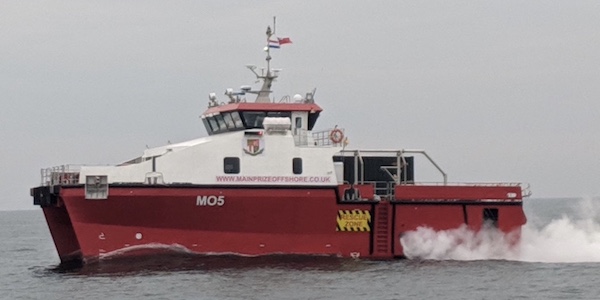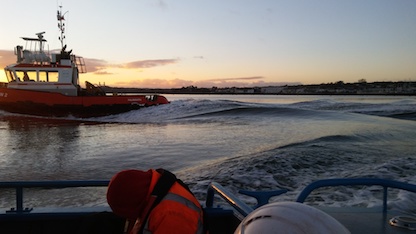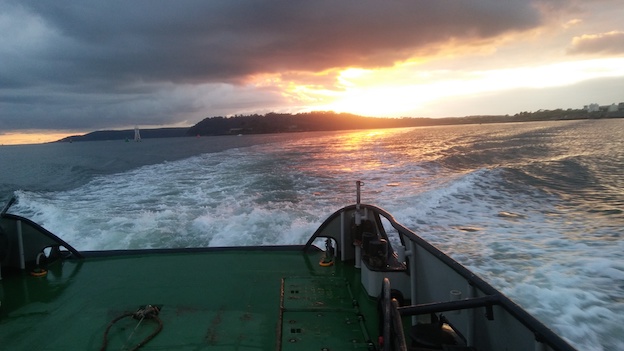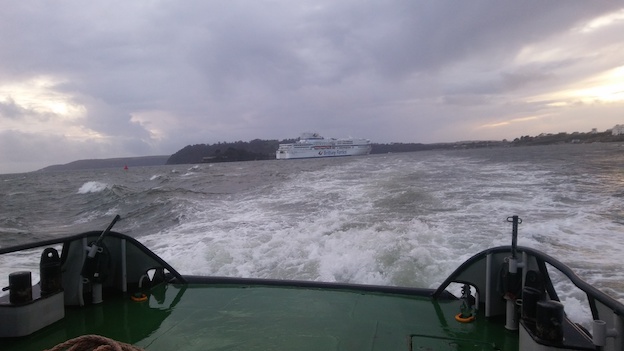
Reality - twin-hull high-speed vessels have been in commercial service
since at least 1990, and many connections are to the "Incat" company
of Hobart, Tasmania, Australia.
Anyway, back to my little article on basic hydrodynamics...
Confined in the same room to "asperg" and be on the same wavelength as a friend studying hard, I did this delightful little study of trivial technical interest.
I worked building some new boats, which was non-stop hard work in a narrow "just do it" focus. The moment I moved-on and had a second to think, that thought was "Hold-on a moment - the service speed of those boats is something odd!" (as in "way too high" (sic.)).
So here we are; these boats. Click on my screengrab to go to that brochure [external link to Walker Marine Design] - all copyright, credit, ownership, etc there.

See "Performance" - that 22knot cruise for 26knot max. is what I'm looking at...
Here's developing the logical argument to inspect the instinct...
I'll delegate Froude number to Wikipedia [external link].
To avoid being irreverent, I'll put it this way - everything to follow my argument at my limited understanding is seen in this Figure from that Wikipedia "Froude Number" page [Wikipedia image displayed here]
Wikipedia : "800px-Froude_numbers_and_waves.png"

As best I understand; Froude came up with this dimensionless group, whose derivation is known. There is a gap between ending on that derivation and arriving at a practical application. However, it can be seen empirically for seawater in Earth's gravity
So "Froude Number" does work. The empirical link provided by these depictions unifies the outcome for different vessels about their calculated Froude Number.
You'll find "Fn=0.4" as the 4th depiction in the above image.
In layperson's terms : the bow-wave rises under the stern.
Even I know what this looks like in real life. Because tugboats egregiously display "Froude hull-speed".
Here in a happy journey home from work is a tugboat just exceeding Fn=0.4; ie just exceeding the Froude hull-speed.


The bow-wave is peaking just behind the stern; not enough to produce the worst effect you can see on tugboats which looks exactly like the "Fn=0.5" "hump speed" depiction second-from-bottom.
From the aft deck of a tugboat, it looks like this:
"Nice" - on the Froude hull-speed at Fn=0.4, with inevitable but well-formed wake

Sorry this is not the most grotesque image - exceeding the Froude hull-speed at Fn>0.4 and you can just about see the stern is lowered and the wake has changed (comparison confounded by being different days with different sea conditions)

(at full power getting to Fn=0.5, the back of the open aft deck will be below sea-level even though the deck remains water-free)
The mathematical expression for Froude number is seen in the Wikipedia article , first equation. As best I can put in flat text, that's Fn=u/sqrt(gL)
Needing to extract a velocity ("speed") u given a
vessel-length L, Gravity g and a
Froude-number Fn, algebraically
Fn=u/sqrt(gL) rearranges to u=Fn*sqrt(gL)
giving the formula needed.
I coded it up as a function in "lisp" to run in the text-processor I am using right now, writing...
(defun v-from-froude-number (froudenum g-grav l-len) "Froude number - hydrodynamics" (* froudenum (sqrt (* g-grav l-len))))
That "length" : the "Supa-Swath" is 26m long, but is 24 metres at the waterline - we'll go with the official "23.88m".
Here's using it.
I've put in the 0.4 of the "Fn=0.4 last efficient hull speed" and 9.81 of the Gravitational force on Earth of 9.81m/s^2 (metres per second-squared); then 23.88 for the waterline length of 23.88m.
[I "fired-up" those functions right there "in-line" in the text and they inserted the answers - I never wrote those two numbers. Good stuff ehh?! :-)]
Therefore...
The actual vessel cruising speed is 22knots and its maximum vessel
speed is 26knots.
The "Froude hull-speed" is 12knots, correctly applying this
tried-and-tested calculation.
These "Supa-swaths" are doing twice the "Froude hull-speed".
Some useful comments about that...
As
If the Froude model applied for these boats then by 15 knots they
would be on the "hump speed", trapped looking like the second-to-last
depiction of the Wikipedia Froude number "Figure" (set of
illustrations).
Which does not happen, with a smooth progression (?) up to the 26
knots at 1600HP (?) from each of their two
Cat C32
[Wikipedia link]
(32L V12 diesel) engines.
You may have already experienced the "hump speed" with a "speedboat" as it sets-off. When powering-up from idling speed in displacement mode, the boat tilts vividly up into the air as the bow rises and the stern lowers - the hump speed. A huge amount of engine power for the boat's size is then needed to get over the hump and onto the plane.
Therefore; to re-emphasise:
These Supa-swaths are doing twice the Froude hull-speed !!!
To have a Froude hull-speed of 22knots you'd need a vessel with a 81.6 metre waterline-length.
(mps2knot (v-from-froude-number 0.4 9.81 81.60811278488816)) ;; 22.0
These "Supa-swaths" are evading capture by the Froude hull-speed
model.
This is both clever and permissible.
There are Laws which have never been known to be broken and can be assumed across the Universe, like "The Law of Conservation of Energy" (example formal statement : "energy can neither be created nor destroyed; rather, it can only be transformed or transferred from one form to another"). Laws cannot be circumvented.
"Froude" is a model, and models are full of "if ... if ... if's".
"If these things are so, and if the connection between cause and
effect were correct, then we predict what would result".
So a model like the Froude Number has selective rather than universal
application.
These boats are blithely doing what they do; regardless of the general rules clearly seen to constrain most other boats.
"The hint is in the name" ;-)
"Supa-Swath" => it's a "SWATH"
A
"Small Waterplane Area Twin Hull"
[Wikipedia external link].
The first paragraph of this article mentions submarines, for which the hydrodynamic rules are different.
The underwater form of these hulls is some impressive sight to see. Drawings in the brochure show what the Companies are happy to reveal.
I imagine - my best guess which could be totally mistaken - that the
designers know / observe some qualitative hydrodynamic effects for
these hulls - perhaps scale models with dye-streams? - and have used
some serious supercomputer "number-crunching" with "Computational
Fluid Dynamics" to quantitatively define these vessels.
Arriving at to-the-millimetre cutting shapes for the aluminium whose
result is these boats which slip through the water.
Well there we have it - an amusing little technical journey recounted
while fitting in with a studious day in one room.
I hope you like it.
Regards,
(R. Smith, investigation/analysis 31Mar2022, writing 31Dec2022,
01Jan2023 (many trimming edits, Fn), 02Jan2023 (many edits & addns),
03Jan2023 (ed, 15kt, C32), 04Jan2023 (timeline), 08Jan2023 (since 1990's)